Acrisols
Table of contents
-
Introduction
-
Parent material and environment
-
Regional Distribution
-
Definition
-
Genesis
-
Characteristics of Acrisols
a. Morphological characteristics
b. Physical characteristics
c. Chemical characteristics
-
Management and Use of Acrisols
1. Introduction
|
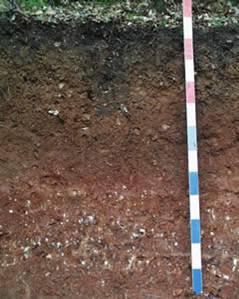 |
| Fig.1 Acrisol |
| (
Source: www.uni-hohenheim.de/.../ profile/profil53.htm) |
|
-
Acrisols [Lat.: acris = very acid] are acid soils with
a sandy-loamy surface soil and accumulation of LAC in an argic B horizon. They
have a low base saturation.
-
Internationally known as:
-
Brazil = Podzolicos vermelho-amarello distroficos a
argila de ativitade baixa
-
Soil Taxonomy (USA) = oxic subgroups of Alfisols
and Ultisols
-
France = Sols ferralitiques fortement ou moyenment
desatures
-
SE-Asia: Red-Yellow Podzols
|
2. Parent material and environment
-
Parent material: most extensive
on acid rock weathering, notably in strongly weathered clays which are
undergoing further degradation.
-
Environment: Acrisols are found
on acid rocks (strongly quartzitic, e.g. granite, gneiss) mostly of Pleistocene
age or older, on old land surfaces with hilly or undulating topography, in
regions with a wet tropical/monsoonal, subtropical or warm temperate climate.
Light forest is the natural vegetation type.
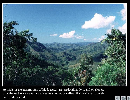 |
| Fig.2 Acrisols in Madagascar |
| (
Source: FAO, 2001.) |
3. Regional Distribution
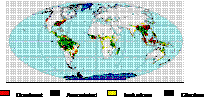 |
| Fig.3 Acrisols worldwide |
| (
Source: FAO, 2001.) |
-
Worldwide are about 1000 Mio. ha of Acrisols. They are most
extensive in SE Asia, S-Amazon, SE USA, E and W-Africa.
4. Definition
-
Must have an argic B horizon within 100 cm or within 200 cm
(when loamy sand is above). Further information in the chapter
(
 clay
eluviation)
. clay
eluviation)
.
-
(
 CEC)
< 24
cmolc/kg (1 M NH4OAc solution
buffered to pH 7) CEC)
< 24
cmolc/kg (1 M NH4OAc solution
buffered to pH 7)
-
 BS < 50 % between 25 and 100 cm
(1 M NH4OAc solution buffered to pH 7) BS < 50 % between 25 and 100 cm
(1 M NH4OAc solution buffered to pH 7)
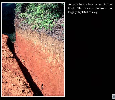 |
| Fig.4 Acrisols have low fertility |
| (
Source: FAO, 2001.) |
5. Genesis
-
Acrisols are characterized by their argic B-horizon,
dominance of stable low activity clays and low base saturation. The formation
of Acrisols involves the following processes:
-
Clay dispersion (see chapter
(
 clay
eluviation)
) clay
eluviation)
)
-
Clay transport
-
Clay accumulation
-
Ferralitization (see chapter
(
 ferralitization)
) ferralitization)
)
-
Translocation of Fe-compounds by
 cheluviation. This process is
accountable for color differentiation directly under the A-horizon where an
eluviation horizon with yellowish colors overlies a more reddish colored
Bst-horizon (see name Red-Yellow Podzolics, SE Asia). cheluviation. This process is
accountable for color differentiation directly under the A-horizon where an
eluviation horizon with yellowish colors overlies a more reddish colored
Bst-horizon (see name Red-Yellow Podzolics, SE Asia).
-
Acrisols are less strongly weathered than
Ferralsols.
6. Characteristics of Acrisols
a. Morphological
characteristics
-
The profile development mostly is AEBtC. Most Acrisols have a
thin, brown, ochric surface horizon, particularly in regions with pronounced
dry seasons. The underlying albic is normally whitish to yellow and overlies a
stronger colored yellow to red argic subsurface horizon.
-
Please look under World Soil Resources Report 94, 2001 for
description of diagnostic horizons and/or materials:
 http://www.fao.org/DOCREP/003/Y1899E/Y1899E00.HTM http://www.fao.org/DOCREP/003/Y1899E/Y1899E00.HTM
b. Physical characteristics
-
Low structural stability. Most Acrisols have weak
microstructure and massive macrostructure, especially in the surface and
shallow subsurface soil that have become depleted of sesquioxides. Bonding
between sesquioxides and negatively charged low activity clays is less strong
than in Ferralsols.
 |
| Fig.5 AEBtC |
| (
Source: soils.usda.gov/.../orders/ alfisols.html) |
c. Chemical characteristics
-
Acrisols have poor chemical properties:
7. Management and Use
-
Due to low inherent chemical and physical properties the
preservation of the surface soil and SOM !!!! is a preconditioning for farming
on Acrisols.
-
The widely used slash-and-burn agriculture is a well adapted
from of land use. Adapted cropping systems with complete fertilization and
careful management are required if sedentary farming is to be
practiced.
-
Undemanding acid tolerant plants such as rubber, oil palm,
pineapple can be grown with some success. Increasing areas of Acrisols are
planted to oil palm (e.g. in Malaysia and on Sumatra).
-
In the Llanos of Colombia, alternation of agriculture and
pasture management including a legume (Arachis pintoi) seems quite successful.
Here Al-tolerant rice is cropped for 2-3 years followed by cropping of N-fixing
fodder plant for 5 years.
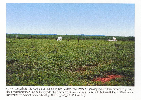 |
| Fig.6 Acrisol landscape |
| (
Source: Zech und Hintermaier-Erhard, 2002.) |
-
Please click on
(
 here)
to look at management and use of
Acrisols. here)
to look at management and use of
Acrisols.
|

 previous | next
previous | next

 previous | next
previous | next